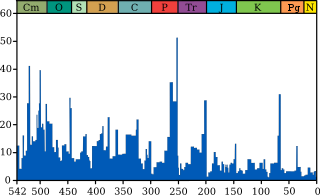Peristiwa kepupusan Perm–Trias
Peristiwa kepupusan Perm-Trias (P-Tr), umumnya dikenali sebagai Kematian Terbesar (Great Dying) atau Kepupusan Perm Terbesar (Great Permian Extinction),[2][3] terjadi sekitar 252 Ma (juta tahun) yang lalu, yang membentuk batas antara tempoh geologi Perm dan Trias, serta era Paleozoik dan Mesozoik. Hal ini ialah peristiwa kepupusan paling parah di bumi yang diketahui, dengan sehingga 96% dari semua spesies laut[4][5] dan 70% dari spesies vertebrata darat menjadi pupus.[6] Ini merupakan satu-satunya kepupusan besar-besaran yang diketahui dari serangga.[7] 57% dari semua familia dan 83% dari semua genera pupus. Kerana begitu banyak biodiversiti yang hilang, pemulihan kehidupan di Bumi memerlukan tempoh secara signifikan lebih lama dari setelah peristiwa kepupusan lain,[4] berkemungkinan sehingga 10 juta tahun.[8]
Rujukan
- ^ Rohde, R.A. & Muller, R.A. (2005). "Cycles in fossil diversity". Nature. 434: 209–210. Bibcode:2005Natur.434..208R. doi:10.1038/nature03339. PMID 15758998.CS1 maint: multiple names: authors list (link)
- ^ ""Great Dying" Lasted 200,000 Years". National Geographic. 23 November 2011. Dicapai pada 1 April 2014.
- ^ "How a Single Act of Evolution Nearly Wiped Out All Life on Earth". ScienceDaily. 1 April 2014. Dicapai pada 1 April 2014.
- ^ a b Benton M J (2005). When life nearly died: the greatest mass extinction of all time. London: Thames & Hudson. ISBN 0-500-28573-X.
- ^ Carl T. Bergstrom; Lee Alan Dugatkin (2012). Evolution. Norton. m/s. 515. ISBN 978-0-393-92592-0.
- ^ Sahney S; Benton M.J (2008). "Recovery from the most profound mass extinction of all time". Proceedings of the Royal Society B. 275 (1636): 759–765. doi:10.1098/rspb.2007.1370. PMC 2596898. PMID 18198148.
- ^ Sole RV, Newman M (2003). "Extinctions and Biodiversity in the Fossil Record". Dalam Canadell JG, Mooney, HA (penyunting). Encyclopedia of Global Environmental Change, The Earth System - Biological and Ecological Dimensions of Global Environmental Change (Volume 2). New York: Wiley. m/s. 297–391. ISBN 0-470-85361-1.CS1 maint: multiple names: editors list (link)
- ^ "It Took Earth Ten Million Years to Recover from Greatest Mass Extinction". ScienceDaily. 27 May 2012. Dicapai pada 28 May 2012.
Bacaan lanjut
- Over, Jess (editor), Understanding Late Devonian and Permian–Triassic Biotic and Climatic Events, (Volume 20 in series Developments in Palaeontology and Stratigraphy (2006). The state of the inquiry into the extinction events.
- Sweet, Walter C. (editor), Permo–Triassic Events in the Eastern Tethys: Stratigraphy Classification and Relations with the Western Tethys (in series World and Regional Geology)
Pautan luar
- "Siberian Traps". Dicapai pada 2011-04-30.
- "Big Bang In Antarctica: Killer Crater Found Under Ice". Dicapai pada 2011-04-30.
- "Global Warming Led To Atmospheric Hydrogen Sulfide And Permian Extinction". Dicapai pada 2011-04-30.
- Morrison D. "Did an Impact Trigger the Permian-Triassic Extinction?". NASA. Diarkibkan daripada yang asal pada 2011-06-10. Dicapai pada 2011-04-30.
- "Permian Extinction Event". Dicapai pada 2011-04-30.
- "Explosive eruption of coal and basalt and the end-Permian mass extinction". Dicapai pada 2011-12-25.
- "BBC Radio 4 In Our Time discussion of the Permian-Triassic boundary". Dicapai pada 2012-02-01. Podcast available.
